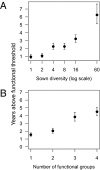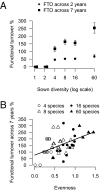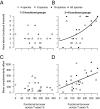More diverse plant communities have higher functioning over time due to turnover in complementary dominant species
- PMID: 21949392
- PMCID: PMC3193239
- DOI: 10.1073/pnas.1104015108
More diverse plant communities have higher functioning over time due to turnover in complementary dominant species
Abstract
More diverse communities have been shown to have higher and more temporally stable ecosystem functioning than less diverse ones, suggesting they should also have a consistently higher level of functioning over time. Diverse communities could maintain consistently high function because the species driving function change over time (functional turnover) or because they are more likely to contain key species with temporally stable functioning. Across 7 y in a large biodiversity experiment, we show that more diverse plant communities had consistently higher productivity, that is, a higher level of functioning over time. We identify the mechanism for this as turnover in the species driving biomass production; this was substantial, and species that were rare in some years became dominant and drove function in other years. Such high turnover allowed functionally more diverse communities to maintain high biomass over time and was associated with higher levels of complementarity effects in these communities. In contrast, turnover in communities composed of functionally similar species did not promote high biomass production over time. Thus, turnover in species promotes consistently high ecosystem function when it sustains functionally complementary interactions between species. Our results strongly reinforce the argument for conservation of high biodiversity.
Conflict of interest statement
The authors declare no conflict of interest.
Figures




References
-
- Balvanera P, et al. Quantifying the evidence for biodiversity effects on ecosystem functioning and services. Ecol Lett. 2006;9:1146–1156. - PubMed
-
- Cardinale BJ, et al. Effects of biodiversity on the functioning of trophic groups and ecosystems. Nature. 2006;443:989–992. - PubMed
-
- Rosenfeld JS. Functional redundancy in ecology and conservation. Oikos. 2002;98:156–162.
-
- Hector A, Bagchi R. Biodiversity and ecosystem multifunctionality. Nature. 2007;448:188–190. - PubMed
-
- Gamfeldt L, Hillebrand H, Jonsson PR. Multiple functions increase the importance of biodiversity for overall ecosystem functioning. Ecology. 2008;89:1223–1231. - PubMed
Publication types
MeSH terms
LinkOut - more resources
Full Text Sources

